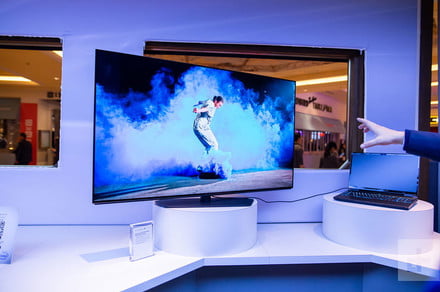Earlier this year at CES 2019, Dell showed us the promise of an exciting new future for gaming monitors with the reveal of the Alienware 55-inch OLED gaming display. And we loved it.
It ticked off all the right boxes; 4K at 120Hz refresh, HDR support, variable refresh rate support with a color gamut up to 95% DCI-P3 that perfectly compliments the inky blacks that OLEDs are famous for. This combination alone immediately made the Alienware 55 stand head and shoulders above current OLED TVs and even the HP Omen X Emperium BFGD. Because it has a DisplayPort 1.4 port, in theory it meant it could have even been G-Sync-compatible upon release.
But a recent report by WCCFTech says that dream Alienware gaming monitor may never see the light of day. The site reports an Alienware executive explaining that it was “a conceptual product that may never be released after all”.
This is quite disappointing given that what Alienware showed off at CES 2019 seemed like a very advanced stages of development. And when we pressed Alienware at the time, they assured us that it wasn’t just a concept but a real product coming out in the second half of this year.
So, why the hesitation to commit? If I’d to make a guess, the answer is probably simple economics. OLED panels are still very expensive to manufacture, even in 2019.
Where’s my OLED?
According to some sources, production cost for a regular 55-inch OLED panel at Samsung is estimated to be around $800. And Samsung — which is the world’s leader in OLED production — still makes a loss on every panel. In reaction, Samsung has since changed focus to the smaller and more profitable smartphone OLED panels.
Now the panel employed in the Alienware 55 isn’t your garden variety OLED either. Compared to standard OLEDs which max out at 60Hz refresh, the Alienware’s 120Hz is undoubtedly much more expensive to construct.
And with an estimated $3,000 price tag for the final retail product, I don’t expect that the Alienware 55 will be flying off the shelves. This price positions it above LG’s best OLED TVs which have the added benefit of smart features and a TV tuner — which the Alienware does not.
That’s a pretty hard sell. Despite the excitement drummed up at CES, I can see why Dell might be hesitant.
And price is not the only challenge here. OLEDs are still known for burn-in. Burn-in occurs when a static image stays too long on the panel and gets stained into it. OLEDs are incredibly susceptible to burn-in as compared to LCDs which is an obvious roadblock to being a good PC gaming monitor. Every PC is constantly displaying static UI elements like menus and status bars for hours on end. And turning to serious gaming marathons, game HUDs that remain on screen for hours could potentially wreak havoc on an OLED.
TV manufacturers use a variety of tricks to prevent burn-in, but the use case of a TV versus a gaming monitor are a bit different. Alienware has to be aware of this and perhaps haven’t yet solved this issue to confidently proceed. Even if there is a solution for this, it’ll take some time to convince the general public. No one wants to pay $3,000 for a screen that might get burn-in within months.
The good news is that these are not insurmountable challenges and with steady improvements in manufacturing processes, we will see more OLEDs going mainstream. Prices are slowly but surely dropping, and OLEDs are starting to show up in more PCs, such as Alienware’s own gaming laptops. The more these OLED screens get into the hands of everyday gamers, the lower the manufacturing prices will drop and the faster public perception will change.
The report concludes noting that Alienware is still considering the viability of the product and an announcement would be made at CES 2020 if it passes the conceptual stage. Hope isn’t completely lost, but for now, the wait for gaming on these dream OLED gaming monitors continues.
Editors’ Recommendations
- The Razer Blade’s new 4K OLED gaming laptop starts at a whopping $3,299
- Dell adds OLED display option to its Alienware M15 gaming laptop
- Alienware Area-51m review
- The best gaming monitors for 2019
- Walmart drops the price on this 24-inch Dell gaming monitor by $149

